Ok. Here's a "short" answer to my question, Where were Russian rulers buried?
The Peter-Paul Cathedral in the Peter and Paul Fortress in St. Petersburg is the site of most of the graves of the Romanov rulers from Peter the Great onward, with Peter's grave is at the front right. (The remains of Nicholas II and his family were re-interred there in 1998). Originally, only the tsar and the immediate family could be buried in the cathedral, but in 1831 Nicholas I decreed that grand dukes and their families could also be buried there; by the end of the nineteenth century, there was not much room left, so a specific grand duke vault was built.
Burial rites were performed in the cathedral for the imperial families alone. Ekaterina, Peter the Great's daughter who died in 1708 at the age of 18 months, was the first to be buried in the cathedral. She was followed by the wife of Peter's son and then Aleksei, Peter's son, himself. On 10 March 1725 Peter the Great and his daughter Natalia were buried, and in 1727 Catherine I (1683-1727), Peter's wife, was buried next to them.
Two Romanov tsars (not counting Nicholas II and his family) did not make it into the Peter-Paul Fortress.
Peter II (1715-1730), grandson of Peter the Great, son of Peter's son Aleksei, became tsar upon the death of Catherine I, Peter's second wife, in 1727. In Moscow, in early January 1730 he caught smallpox and died 19 January 1730. He was buried in the Archangel Cathedral of the Kremlin (see below). His death ended the male line of the Romanov Dynasty.
Ivan VI (1740-1764) lead a truly unfortunate life. His great aunt, Empress Anna I (1693-1740) who was the daughter of Peter the Great's step brother Ivan V (1666-1696), adopted Ivan as heir to the throne of Russia on 5 October 1640--Ivan was two months old. Anna died on 28 October, and Ivan VI became the new tsar with a regency set up. In November 1741, the regency was overthrown by the Imperial Guard in favor of Peter the Great's illegitimate daughter, Elizabeth I (1709-1762). Ivan VI spent the next twenty-odd years in one prison after another, essentially in secret isolation. When Catherine the Great assumed the throne of Russia by having her husband, Peter III (1728-1762) murdered, it was not good to have another legitimate tsar still hanging around somewhere. When a plot unraveled to free Ivan from his imprisonment, he was executed. He was secretly buried in a hidden place near the walls of the Shlisselburg Fortress. (The fortress is located where the Neva River flows from Lake Ladoga.) The grave was later destroyed.
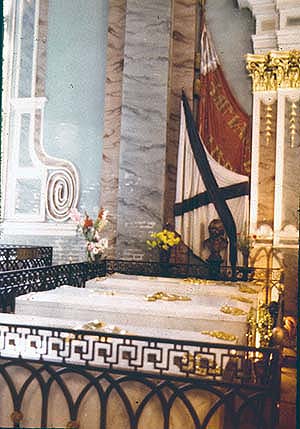
Flowers adorn the tomb of Peter the Great in the back.
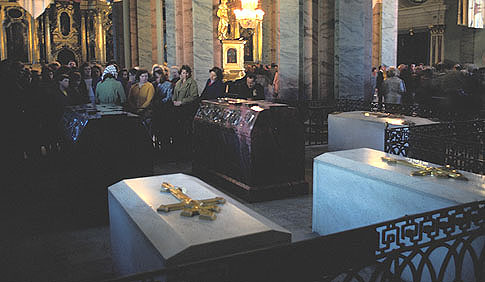
The large tombs (green and red) are for Alexander II and his wife. Photo by Bev Blois.

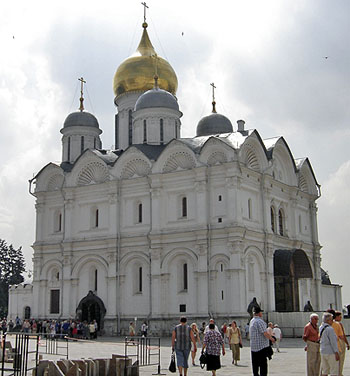
The Cathedral of the Archangel (Архангельский собор) in the Kremlin.
The Cathedral of the Archangel in the Moscow Kremlin was the burial place for the rulers of Muscovy from the Grand Prince Ivan I Kalita (1328-1341) to Tsar Ivan V (1682-1696), the half-brother of Peter the Great, and including Dmitrii Donskoi (1350-1389), who inflicted the first defeat of the Mongols in 1380 and Mikhail Romanov (1596-1645), the founder of the Romanov dynasty. You cannot see the tombs of Ivan the Terrible and his sons, Ivan and Fedor, which are hidden behind the iconostasis and not accessible to visitors. The bodies all lie in stone sarcophagi carved in the seventeenth century. Boris Godunov (1551-1605) is the exception; he was not buried here but at the Trinity-Sergius Lavra (Троице-Сергиева Лавра) in Sergiev Posad, now Zagorsk) outside of Moscow.
Some websites on the Archangel Cathedral:
Some other images of the Archangel Cathedral:
- Entrance (Image: Wikipedia,
August 2003 by Stan Shebs)
- Interior Iconostasis
- Interior Overhead (Image: Wikipedia,
August 2003 by Stan Shebs)

Saint Sophia Cathedral in Kiev was originally the burial place of the Kievan Grand Princes including Vladimir Monomakh (1053-1125), Vsevolod Iaroslavich (1030-1093) and Iaroslav I the Wise, (978-1054) although only the latter's grave has survived. While speaking of Kiev, let's not forget Iurii Dolgorukii (1099-1157), who was interred at the Saviour Church of Berestovo, which still stands in Kiev.
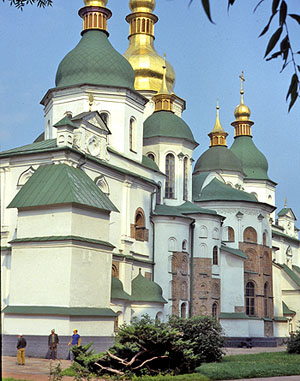
St. Sophia Cathedral in Kiev

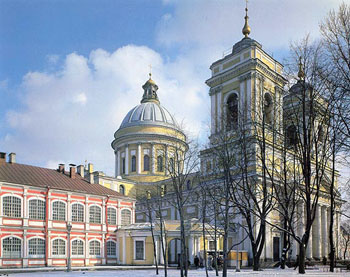
The Holy Trinity Cathedral of the Aleksandr Nevskii Lavra
The Aleksandr Nevskii Lavra in St. Petersburg is the final resting place of Saint Prince Alexander Nevskii (1219-1263), who had originally been buried in Vladimir. In 1724, on the orders of Peter the Great, the remains were transferred to the Aleksandr Nevskii Lavra, which was founded in honor of Nevskii. The Holy Trinity Cathedral (Cвято-Троицкий собор) houses the main relics of Alexander Nevskii.
Note that when Paul I became tsar in
1796, he had the remains of Peter III moved from the Aleksandr Nevskii Lavra
to the Peter-Paul Fortress to be placed beside Catherine the Great. (Explanation)